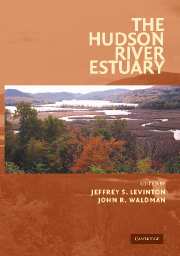Book contents
- Frontmatter
- Contents
- Preface
- List of Contributors
- The Hudson River Estuary
- 1 The Hudson River Estuary: Executive Summary
- GEOLOGICAL, PHYSICAL, AND CHEMICAL SETTING OF THE HUDSON
- PRIMARY PRODUCTION, MICROBIAL DYNAMICS, AND NUTRIENT DYNAMICS OF THE HUDSON
- HUDSON RIVER COMMUNITIES, FOOD WEBS, AND FISHERIES
- 12 Larval Migrations Between the Hudson River Estuary and New York Bight
- 13 The Diadromous Fish Fauna of the Hudson River: Life Histories, Conservation Concerns, and Research Avenues
- 14 Fisheries of the Hudson River Estuary
- 15 The Role of Tributaries in the Biology of Hudson River Fishes
- 16 Ecology of the Hudson River Zooplankton Community
- 17 Submersed Macrophyte Distribution and Function in the Tidal Freshwater Hudson River
- 18 Long-Term and Large-Scale Patterns in the Benthic Communities of New York Harbor
- 19 The Benthic Animal Communities of the Tidal-Freshwater Hudson River Estuary
- 20 Tidal Wetlands of the Hudson River Estuary
- 21 Alien Species in the Hudson River
- CONTAMINANTS AND MANAGEMENT ISSUES OF THE HUDSON RIVER ESTUARY
- Index
- Plate section
- References
21 - Alien Species in the Hudson River
Published online by Cambridge University Press: 06 January 2010
- Frontmatter
- Contents
- Preface
- List of Contributors
- The Hudson River Estuary
- 1 The Hudson River Estuary: Executive Summary
- GEOLOGICAL, PHYSICAL, AND CHEMICAL SETTING OF THE HUDSON
- PRIMARY PRODUCTION, MICROBIAL DYNAMICS, AND NUTRIENT DYNAMICS OF THE HUDSON
- HUDSON RIVER COMMUNITIES, FOOD WEBS, AND FISHERIES
- 12 Larval Migrations Between the Hudson River Estuary and New York Bight
- 13 The Diadromous Fish Fauna of the Hudson River: Life Histories, Conservation Concerns, and Research Avenues
- 14 Fisheries of the Hudson River Estuary
- 15 The Role of Tributaries in the Biology of Hudson River Fishes
- 16 Ecology of the Hudson River Zooplankton Community
- 17 Submersed Macrophyte Distribution and Function in the Tidal Freshwater Hudson River
- 18 Long-Term and Large-Scale Patterns in the Benthic Communities of New York Harbor
- 19 The Benthic Animal Communities of the Tidal-Freshwater Hudson River Estuary
- 20 Tidal Wetlands of the Hudson River Estuary
- 21 Alien Species in the Hudson River
- CONTAMINANTS AND MANAGEMENT ISSUES OF THE HUDSON RIVER ESTUARY
- Index
- Plate section
- References
Summary
abstract Like most estuaries, the Hudson has been heavily invaded by alien species (those moved out of their native ranges by human activities). The Hudson and its tributaries now contain more than 100 alien species, which are abundant in every habitat in the basin. Invasions of the freshwater part of the basin (aliens in brackish waters of the basin have not been systematically studied) were underway by the early nineteenth century, and continue at a rate of ∼7 new species per decade. Most of these species came from Europe or the Great Lakes through shipping activities, the Erie Canal, or deliberate introductions. Case studies of selected aliens (the zebra mussel, black bass, water-chestnut, Atlantic rangia, and Asian shore crab) show that alien species have had large and varied ecological impacts on all parts of the Hudson estuary. The impacts of alien species on the Hudson are likely to increase in the future as new aliens become established. We may be able to reduce future undesirable impacts of aliens on the Hudson by controlling or eradicating undesirable species, in the few cases where this is feasible; aggressively reducing the numbers of alien species that are inadvertently transported by human activities; and adopting more stringent criteria for allowing the intentional introduction of species.
Introduction
Most people know that humans have deeply affected the Earth's ecosystems by pollution, changes in land use, and overharvesting of wild plants and animals.
- Type
- Chapter
- Information
- The Hudson River Estuary , pp. 296 - 310Publisher: Cambridge University PressPrint publication year: 2006
References
- 5
- Cited by



